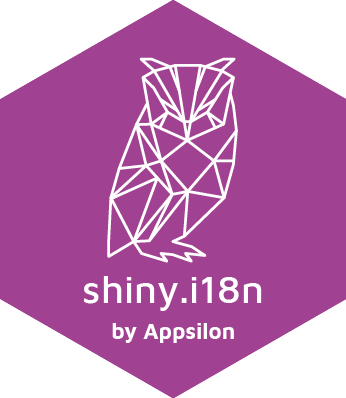

Shiny applications internationalization made easy!
Using it is very simple: just prepare your translation files in one of the supported formats, read them into your app using user-friendly shiny.i18n interface and surround your expressions to translate by a translator tag. Thanks to that your app will remain neat and readable.
Actually, you can use shiny.i18n as a standalone R package - shiny app is just a perfect use-case example.
Change languages and formats easy with shiny.i18n.
Stable version:
install.packages("shiny.i18n")Development version:
remotes::install_github("Appsilon/shiny.i18n")
You can find some basic examples in examples folder:
Using i18n object with CSV translation files or JSON translation files.
Live language change on the browser side or with the server function renderUI.
Example of translation data format.
shiny.i18n works seamlessly with Quarto.
shiny.i18n also works when used in interactive Quarto + Shiny instances. Alternatively, you can also experience a deployed version.
Currently shiny.i18n supports two translation formats:
translation_<LANGUAGE-CODE>.csv containing two
columns: key translation, language to which it needs to be translated.
Example of translation_pl.csv for Polish language you may
find here: inst/examples/data/translation_pl.csv. You load
the data by passing the path to folder containing all the csv
files:Translator$new(translation_csvs_path = "...")translation.json with mandatory fields:
"languages" with list of all language codes and
"translation" with list of dictionaries assigning each
translation to a language code. Example of such a json file for Polish
language you may find here:
inst/examples/data/translation.json. You load the data by
passing the path to json file.Translator$new(translation_json_path = "...")shiny.i18n and
rhinoshiny.i18n can be used to add live language change
feature to Shiny applications built using Rhino framework. For more
details, check this
tutorial.
If you want to contribute to this project please submit a regular PR, once you’re done with a new feature or bug fix.
Reporting a bug is also helpful - please use GitHub issues and describe your problem as detailed as possible.
Appsilon is a Posit (formerly RStudio) Full Service Certified
Partner.
Learn more at appsilon.com.
Get in touch opensource@appsilon.com
Check our Open Source tools.